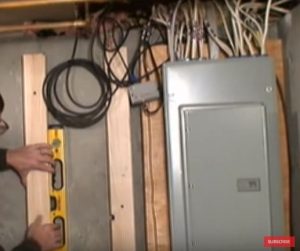Use Concrete Fasteners to Attach Furring Strips to Concrete and Brick Walls
By Mark J. Donovan
|
|
How to Install Furring strips for Drywall?
The most common way to hang drywall on concrete basement walls or brick walls is to use furring strips. Furring strips are narrow 1”x3” lengths of lumber that are normally fastened vertically along the length of the wall. Alternatively 2”x3”s or 2×4”s can be used. Typically the furring strips are spaced on 16” or 24” centers, so that they can easily support the widths of 4’ wide drywall. |
Once the furring strips have been fastened to the concrete basement walls or brick walls, the drywall can then be attached to the furring strips using standard 1 inch drywall nails or screws.
In addition, rigid foam insulation can also be installed in between the furring strips, prior to attaching the drywall.
To fasten furring strips to concrete basement walls or brick walls, typically a concrete fastener is used. Concrete fasteners include concrete screws and sleeve anchors. Concrete fasteners can be used on concrete, brick and cinder block walls. With either you need to pre-drill a hole in the concrete or brick using a hammer drill and carbide masonry bit. The hole depth should be around 1.5 inches.
| Before inserting the concrete fastener make sure you thoroughly clean out the hole with a shopvac.
It is important that the hole is thoroughly clean of dust and debris to ensure a solid bond between the fastener and concrete or brick. Note you can attach the concrete fasteners into the mortar between bricks; however the strength of the holding bond is directly proportional to the quality of the mortar. |
 |
After drilling and cleaning the hole, affix the furring strip to the concrete basement wall or brick wall by inserting the screw or sleeve anchor through the furring strip and into the hole drilled into the concrete or brick. Tighten the screw or sleeve anchor with a socket wrench, however be careful to not over tighten. You should install a concrete fastener every 24” along the length of each furring strip.
Once the furring strips have been fastened to the concrete basement walls or brick walls, the drywall or other wall covering can then be attached to the furring strips.
For more help on Basement Additions, see HomeAdditionPlus.com’s Basement Remodeling Bid sheet. The Basement Remodeling Bid Sheet will help ensure that your hire the right contractor so that your basement remodeling project is done correctly and you get the project finished on time and budget.
Related Information
- Using Furring Shims for Framing Basement Walls
- Fastening Framed Walls to Concrete Floor with Powder Actuated Nail Gun
- Tips on Ensuring a Waterproof Basement
- How to Install Furring Strips for Drywall
Get Free Basement Remodeling Price Quotes with No Obligation!
Fill out our 3-5 minute quick and easy form, and receive a free price quote on basement remodeling from one of our prescreened and licensed basement remodeling contractors. This process is free and there is no obligation to continue once you receive your basement remodeling price estimate.

